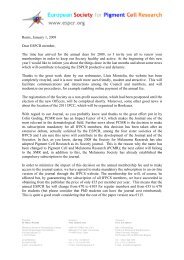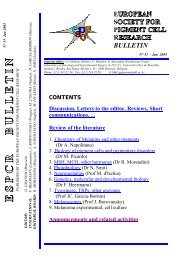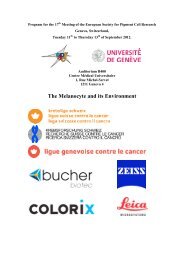released by the Organizers - European Society for Pigment Cell ...
released by the Organizers - European Society for Pigment Cell ...
released by the Organizers - European Society for Pigment Cell ...
Create successful ePaper yourself
Turn your PDF publications into a flip-book with our unique Google optimized e-Paper software.
Programme<br />
16th Meeting of <strong>the</strong> <strong>European</strong> <strong>Society</strong> <strong>for</strong> <strong>Pigment</strong> <strong>Cell</strong> Research<br />
Wellcome Trust Conference Centre, Hinxton, UK<br />
4-7 September 2010<br />
Oral Presentations<br />
If you are an invited speaker, or your abstract has been selected <strong>for</strong> an oral presentation,<br />
please give an electronic version of your talk to an AV technician in <strong>the</strong> Auditorium, <strong>the</strong><br />
morning of your talk.<br />
Poster Presentations<br />
Posters will be displayed throughout <strong>the</strong> conference in <strong>the</strong> Cloisters. Your abstract page<br />
number indicates your poster boards number.<br />
_________________________________________________________________________<br />
Saturday 4 September 2010<br />
10.00-12.00 ESPCR Council Meeting (Council Members Only)<br />
Library<br />
12.00-18.00 Registration (with lunch from 12.00-13.50)<br />
Conference Centre Foyer<br />
12.00-13.50 Lunch<br />
Conference Centre Foyer<br />
13.50, Conference Opening (Robert Kelsh)<br />
Francis Crick Auditorium, Wellcome Trust Conference Centre<br />
14.00-15.00 Fritz Anders Memorial Lecture<br />
Development and function of retinal pigment epi<strong>the</strong>lium cells<br />
Heinz Arnheiter, Mammalian Development Section, NIH, USA<br />
Introduced <strong>by</strong> Lionel Larue<br />
The ESPCR Lecture<br />
Session 1 Development biology of pigment cells and MSCs<br />
Francis Crick Auditorium, Wellcome Trust Conference Centre<br />
Chair: Veronique Delmas and Takahiro Kunisada<br />
15.00-15.25 The chromatoblast concept – evidence from zebrafish genetics<br />
Robert Kelsh, University of Bath, UK<br />
15.25-15.50 Biological and ma<strong>the</strong>matical modeling of melanocyte development<br />
Lionel Larue, Institut Curie, France<br />
15.50-16.15 Regulation of <strong>the</strong> zebrafish melanocyte stem cell<br />
Stephen Johnson, Washington University Medical School, USA
16.15-16.30 Raf signalling is dispensable <strong>for</strong> early melanocyte lineage development but<br />
required <strong>for</strong> melanocyte stem cell self-maintenance<br />
Aga<strong>the</strong> Valluet, Institut Curie, France<br />
16.30-16.45 An integrated approach to melanoblast behaviour during embryonic<br />
development<br />
Richard Mort, Medical Research Council, UK<br />
17.00-18.00 Pre Dinner Drinks<br />
Conference Centre Foyer and Cloisters<br />
18.00-19.00 Dinner<br />
Hall Restaurant<br />
Session 2 Genetics of pigment cell transcription<br />
Francis Crick Auditorium, Wellcome Trust Conference Centre<br />
Chair: Vittoria Schiaffino and Eirikur Steingrímsson<br />
19.00-19.25 Complex regulation of <strong>the</strong> MC1R underscores its central role in controlling<br />
human pigmentation and <strong>the</strong> UV response<br />
Zalfa Abdel-Malek, University of Cincinnati, USA<br />
19.25-19.50 Regulation of Mitf <strong>by</strong> acetylation and novel insights from <strong>the</strong> crystal structure<br />
Eirikur Steingrímsson, University of Iceland, Faculty of Medicine, Iceland<br />
19.50-20.15 Analysis of Mitf in Drosophila<br />
Francesca Pignoni, SUNY Upstate Medical University, USA<br />
20.15-20.30 A melanoma specific function of beta-catenin<br />
Claudia Wellbrock, University of Manchester, UK<br />
20.30-20.45 Overexpression of <strong>the</strong> Strawberry Notch homolog 2 gene in <strong>the</strong> melanocyte<br />
lineage triggers a fate switch in melanocyte stem cells<br />
Genevieve Aubin-Houzelstein, INRA, France<br />
20.45-21.00 Notch targets in melanocytes<br />
Bhushan Sarode, EPFL, Lausanne,Switzerland<br />
21.00 Bar open<br />
Hall Bar<br />
21.30 Shuttle Service to Homerton College<br />
Sunday 5 September 2010<br />
07.30 Breakfast<br />
Hall Restaurant<br />
07.30 Breakfast<br />
Homerton College<br />
08.00 Shuttle service from Homerton College to Conference Centre
Session 3 <strong>Pigment</strong>ary Disorders<br />
Francis Crick Auditorium, Wellcome Trust Conference Centre<br />
Chair: Prasad Kumarasinghe and Lluis Montoliu<br />
08.45-09.10 Towards a universal genetic diagnosis of all types of albinism<br />
Lluis Montoliu, Centro Nacional de Biotecnologia (CNB-CSIC), Spain<br />
09.10-09.35 <strong>Pigment</strong>ary mosaicism: patterns and mechanisms<br />
Rudolf Happle, Philipp University of Marburg, Germany<br />
09.35-10.00 Hsp70i as <strong>the</strong> sole requirement <strong>for</strong> activating depigmentation in vitiligo-prone<br />
mice<br />
Caroline Le Poole, Loyola University Chicago, USA<br />
10.00-10.15 Long-term follow up on Scenesse® (Afamelanotide, an alpha-MSH<br />
analogue) in patients with erythropoietic protoporphyria (EPP)<br />
Elisabeth Minder, Stadtspital Triemli, Switzerland<br />
10.15-11.00 Morning Coffee<br />
Conference Centre Foyer and Cloisters<br />
Session 4 Melanocyte cell biology<br />
Francis Crick Auditorium, Wellcome Trust Conference Centre<br />
Chair: Graça Raposo and Miguel Seabra<br />
11.00-11.25 The biogenesis of melanosomes: <strong>Cell</strong>ular and molecular mechanisms.<br />
Graça Raposo, Institut Curie, France<br />
11.25-11.50 Mechanisms of Melanosome transfer in human skin<br />
Miguel Seabra, Imperial College London, UK<br />
11.50-12.15 Skin as a living coloring book: epi<strong>the</strong>lial cell roles in <strong>the</strong> patterning of<br />
pigmentation<br />
Janice Brissette, SUNY Downstate Medical Center, USA<br />
12.15-12.30 A new spectrophotometric method <strong>for</strong> simple quantitation of melanosomal<br />
transfer from melanocytes to keratinocytes: The trans-membrane<br />
melanosomal transfer method<br />
Behrooz Kasraee, Geneva University Hospital, Switzerland<br />
12.30-12.45 Development of a 3D pigmented skin model to evaluate RNAi-induced<br />
pigmentation<br />
Mireille van Gele, Ghent University Hospital, Belgium<br />
13.00-14.00 Lunch<br />
Hall Restaurant<br />
13.00-14.00 Vitiligo <strong>European</strong> Task Force (members only)<br />
Pompeiian Room
Session 5 Melanoma biology and <strong>the</strong>rapeutics<br />
Francis Crick Auditorium, Wellcome Trust Conference Centre<br />
Chair: Richard Marais and Kyoung Chan Park<br />
Session sponsored <strong>by</strong> Cancer Research UK<br />
14.00-14.25 BRAF and RAS signalling in human melanoma<br />
Richard Marais, The Institute of Cancer Research, UK<br />
14.25- 14.50 The signalling and transcription network regulating cell fate switching in<br />
melanocytes and melanoma<br />
Colin Goding, Ludwig Institute <strong>for</strong> Cancer Research, UK<br />
14.50-15.15 β-catenin LEF/TCF co-factors are expressed according to <strong>the</strong> rhythm of<br />
melanoma progression<br />
Keith Hoek, University Hospital of Zurich, Switzerland<br />
15.15-15.30 MITF is <strong>the</strong> key molecular switch between melanoma initiating cells and <strong>the</strong>ir<br />
differentiated progeny<br />
Robert Ballotti, INSERM U895, France<br />
15.30-15.45 Loss of E-cadherin increases metastatic potential of melanoma<br />
Veronique Delmas, Institut Curie, France<br />
16.00-16.30 Afternoon Tea<br />
Conference Centre Foyer and Cloisters<br />
Session 6 Melanocytes, migration and melanoma<br />
Francis Crick Auditorium, Wellcome Trust Conference Centre<br />
Chair: Lionel Larue and Elizabeth Patton<br />
16.30-16.55 Imaging melanoma dissemination<br />
Erik Sahai, Cancer Research UK London Research Institute, UK<br />
16.55-17.20 MITF controls <strong>the</strong> DNA Damage Response and a lineage specific senescence<br />
program in melanomas<br />
Corine Bertolotto, INSERM U895, France<br />
17.20-17.45 A small molecule screen <strong>for</strong> enhancers of melanocyte regeneration: a novel<br />
role <strong>for</strong> <strong>the</strong> Prl-3 phosphatase<br />
Elizabeth Patton, MRC Human Genetics Unit, UK<br />
17.45-18.00 Early onset and highly penetrant melanoma in zebrafish derives from<br />
trans<strong>for</strong>mation of larval melanocytes<br />
Marina Mione, IFOM, Italy<br />
18.00-18.15 Functional characterization of STX17 in Gray horse melanoma<br />
Anna Golovko, Uppsala University, Sweden<br />
18.30-19.30 Drinks Reception<br />
Conference Centre Foyer and Cloisters
19.30-20.30 Dinner<br />
Hall Restaurant<br />
19.00-21.00 IFPCS Council Meeting (Council Members only)<br />
Library<br />
21.00-23.00 IFPCS Council dinner (Council Members only)<br />
Pompeiian Room<br />
20.30 Posters Session I & Cash Bar<br />
Conference Centre Cloisters<br />
21.30 Shuttle Service to Homerton College<br />
Monday 6 September 2010<br />
07.30 Breakfast<br />
Hall Restaurant<br />
07.15 Breakfast<br />
Homerton College<br />
07.45 Shuttle service from Homerton College to Conference Centre<br />
Session 7 Senescence<br />
Francis Crick Auditorium, Wellcome Trust Conference Centre<br />
Chair: Robert Ballotti and Dorothy Bennett<br />
08.30-08.45 IFPCS and <strong>the</strong> IPCC, Shigeki Shibahara; IPCC 2011, Alain Taïeb<br />
08.45-09.10 Oncogene-induced cell senescence and its relevance <strong>for</strong> melanoma<br />
Daniel Peeper, Ne<strong>the</strong>rlands Cancer Institute, The Ne<strong>the</strong>rlands<br />
The EMBO Lecture<br />
09.10-09.35 Regulation and <strong>the</strong>rapeutic impact of intracellular degradation pathways in<br />
melanoma<br />
Maria Soengas, Spanish National Cancer Research Centre, Spain<br />
09.35-10.00 Treating <strong>the</strong> untreatable? <strong>Cell</strong>-based screening <strong>for</strong> senescence-based<br />
cancer drug discovery<br />
Dorothy Bennett, St George's, University of London, UK<br />
10.00-10.15 Melanoma inhibitory activity (MIA) acts as a mediator of oncogene-induced<br />
senescence in human melanocytes<br />
Susanne Schiffner, University of Regensburg, Germany<br />
10.15-10.45 Morning Coffee<br />
Conference Centre Foyer and Cloisters
Session 8 Signalling pathways in melanocytes and melanoma cells<br />
Francis Crick Auditorium, Wellcome Trust Conference Centre<br />
Chair: Anja Bosserhoff and Colin Goding<br />
10.45-11.10 GLI2, not just a Hedgehog mediator – Its role in melanoma metastasis<br />
Alain Mauviel, Institut Curie, France<br />
11.10-11.35 Multiplicity and complexity of <strong>the</strong> OA1 signaling pathway(s)<br />
Vittoria Schiaffino, San Raffaele Scientific Institute, Italy<br />
11.35-12.00 Non-canonical signaling from wild type and mutant human melanocortin 1<br />
receptor (MC1R)<br />
José Carlos García-Borrón, University of Murcia, Spain<br />
The Clinuvel Lecture<br />
12.00-12.15 Identification of novel mutations affecting MC1R signalling<br />
Ian Jackson, MRC Human Genetics Unit, UK<br />
12.15-12.30 Signals involved in oncogenic activities of metabotropic glutamate receptor 1<br />
Yoko Funasaka, Nippon Medical School, Japan<br />
12.30-14.00 Lunch<br />
Hall Restaurant<br />
13.00-14.00 ESPCR General Assembly<br />
Francis Crick Auditorium<br />
Session 9 Genetics of melanocyte and melanoma development<br />
Francis Crick Auditorium, Wellcome Trust Conference Centre<br />
Chair: Keith Hoek and Julia Newton Bishop<br />
14.00-14.25 Migratory pathways and cellular mechanisms of melanocyte development<br />
Patrik Ern<strong>for</strong>s, TBC<br />
14.25-14.50 A role <strong>for</strong> ATF2 in regulating MITF and melanoma development<br />
Ze’ev Ronai, San<strong>for</strong>d-Burnham, USA<br />
14.50-15.15 Human pigmentation genes and novel genetic susceptibilities to melanoma: a<br />
candidate gene approach using <strong>the</strong> Illumina plat<strong>for</strong>m<br />
Gloria Ribas, Fundacion Investigacion Hospital Clinico Valencia, Spain<br />
15.15-15.30 TYRP1 function in melanoma progression<br />
Marie-Dominique Galibert, CNRS UR6061 – IGDR, France<br />
15.30-15.45 NR4A nuclear receptors mediate normal and oncogenic signalling in<br />
melanocytic cells.<br />
Aaron Smith, University of Queensland, Australia<br />
15.45-17.45 Afternoon Tea and Poster Session II<br />
Conference Centre Cloisters
17.45-18.45 Plenary Lecture 1: Gene expression in cellular senescence<br />
Masashi Narita, Cancer Research UK Cambridge Research Institute, UK<br />
introduced <strong>by</strong> Dorothy Bennett<br />
19.00 Buses to Conference Dinner in Cambridge<br />
19.30-23.00 Drinks Reception and Conference Dinner at Queens College in Cambridge<br />
23.00 Coaches return to Homerton College and Conference Centre<br />
Tuesday 7 September 2010<br />
07.30 Breakfast<br />
Hall Restaurant<br />
07.30 Breakfast<br />
Homerton College<br />
08.00 Shuttle service from Homerton College to Conference Centre<br />
Session 10 The sun, DNA damage and epidermal biology<br />
Francis Crick Auditorium, Wellcome Trust Conference Centre<br />
Chair: Markus Böhm and Yoko Funasaka<br />
08.45-09.10 Chk1 is essential <strong>for</strong> skin tumorigenesis<br />
David Gillespie, Beatson Institute <strong>for</strong> Cancer Research, UK<br />
09.10-09.35 Truncated alpha-MSH tripeptides and derivatives –novel tools <strong>for</strong> <strong>the</strong><br />
prevention of UVB-induced stress and inflammation<br />
Markus Böhm, University of Münster, Germany<br />
09.35-10.00 The sun, vitamin D and melanoma<br />
Julia Newton-Bishop, University of Leeds, UK<br />
10.00-10.15 In vivo identification of solar radiation-responsive gene network: role of <strong>the</strong><br />
p38 stress-dependent kinase<br />
Nicolas Mouchet, CNRS UMR6061, France<br />
10.15-10.45 Morning Coffee<br />
Conference Centre Foyer and Cloisters<br />
10.45-11.45 Plenary Lecture 2: Stem cells in mammalian epidermis<br />
Fiona Watt, Cancer Research UK Cambridge Research Institute, UK<br />
introduced <strong>by</strong> Robert Kelsh<br />
12.00-13.00 Lunch<br />
Hall Restaurant<br />
13.00-16.00 Three parallel Workshops
Workshop A – <strong>Pigment</strong> patterns – <strong>the</strong>ir <strong>for</strong>mation and evolution<br />
Francis Crick Auditorium, Wellcome Trust Conference Centre<br />
Chairs: Greg Barsh and Nick Mundy<br />
13.00-13.25 Evolutionary genetics of melanin-based plumage polymorphisms in buzzards<br />
and skuas<br />
Nick Mundy, University of Cambridge, UK<br />
13.25-13.50 Mammalian pigmentation patterns<br />
Greg Barsh, HudsonAlpha Institute, USA<br />
13.50-14.15 Interactions between zebrafish pigment cells responsible <strong>for</strong> <strong>the</strong> generation of<br />
Turing patterns<br />
Shigeru Kondo, Osaka University, Japan<br />
14.15-14.30 Chemico-genetic analysis of <strong>the</strong> parade mutant; insights into embryonic<br />
pigment pattern <strong>for</strong>mation in zebrafish<br />
Sarah Colanesi, University of Bath, UK<br />
14.30-14.45 Analysis of coat colour loci in Vicugna Pacos (Alpaca) and association with<br />
coat colour variation<br />
Natasha Feeley, Curtin University, Australia<br />
14.45-15.00 SLC24A5 and cholesterol homeostasis – a route to human skin colour<br />
variation?<br />
Rebecca Ginger, Unilever R&D, USA<br />
15.00-15.15 Solute Carrier Family 45 Member 2 (Slc45a2) of <strong>the</strong> Guppy: Molecular<br />
cloning, polymorphisms and fine mapping of genomic region<br />
Verena Kottler, Max Planck Institute <strong>for</strong> Developmental Biology, Germany<br />
Workshop B – Function and <strong>for</strong>mation of <strong>the</strong> melanosome<br />
James Watson Pavilion, Wellcome Trust Conference Centre<br />
Chairs: Marco d’Ischia and José Carlos García-Borrón<br />
13.00-13.25 The dark side of pigment cells: from DHICA to eumelanin, key issues and<br />
clues from chemistry<br />
Marco d’Ischia, University of Naples Federico II, Italy<br />
13.25-13.50 Activation of 3-O-(3,4,5-trimethoxybenzoyl)-(-)-epicatechin in melanoma to a<br />
potent irreversible inhibitor of dihydrofolate reductase<br />
Jose Neptuno Rodriguez-Lopez, University of Murcia, Spain<br />
13.50-14.05 Rab GTPases, <strong>the</strong> recycling endosome and regulation of melanosome<br />
trafficking and release<br />
Kimberley Beaumont, University of Queensland, Australia<br />
14.05-14.20 Intracellular sorting of <strong>the</strong> melanosomal G protein-coupled receptor OA1<br />
involves ubiquitination and ESCRT function<br />
Francesca Giordano, Institut Curie, France<br />
14.20-14.35 Isoquinoline building blocks in red hair pheomelanin uncovered<br />
Alessandra Napolitano, University of Naples Federico II, Italy
Workshop C – Vitiligo<br />
Rosalind Franklin Pavilion, Wellcome Trust Conference Centre<br />
Chairs: Mauro Picardo and Alain Taïeb<br />
13.00-13.25 Vitiligo: emerging targets to limit <strong>the</strong> subclinical inflammatory phase<br />
Alain Taïeb, CHU Bordeaux, France<br />
13.25-13.50 Lipid modification in vitiligo melanocytes: a possible role in <strong>the</strong> alteration of<br />
signal transduction pathways.<br />
Mauro Picardo, San Gallicano Dermatologic Institute - IRCCS Rome, Italy<br />
13.50-14.15 Role of apoptosis and melanocytorrhagy: A comparative study of<br />
melanocytes adhesion in stable and unstable vitiligo<br />
Davinder Parsad, Postgraduate Institute of Medical Education & Research,<br />
India<br />
14.15-14.30 The topical improvement of <strong>the</strong> marginal repigmentation pattern of vitiligo<br />
Yvon Gauthier, Dermatologie, France<br />
14.30-14.45 What are <strong>the</strong> priorities <strong>for</strong> clinical research in vitiligo?<br />
Viktoria Elef<strong>the</strong>riadou, University of Nottingham, UK<br />
14.45-15.00 Presence versus absence of autoimmunity in non segmental vitiligo patients<br />
Silvia Moretti, University of Florence, Italy<br />
15.00-15.15 Prognostic value of halo nevi in vitiligo<br />
Nanja van Geel, Ghent University Hospital, Belgium<br />
16.00 Conference Closure<br />
16.30 Coaches to Cambridge, Stansted and Heathrow depart.







